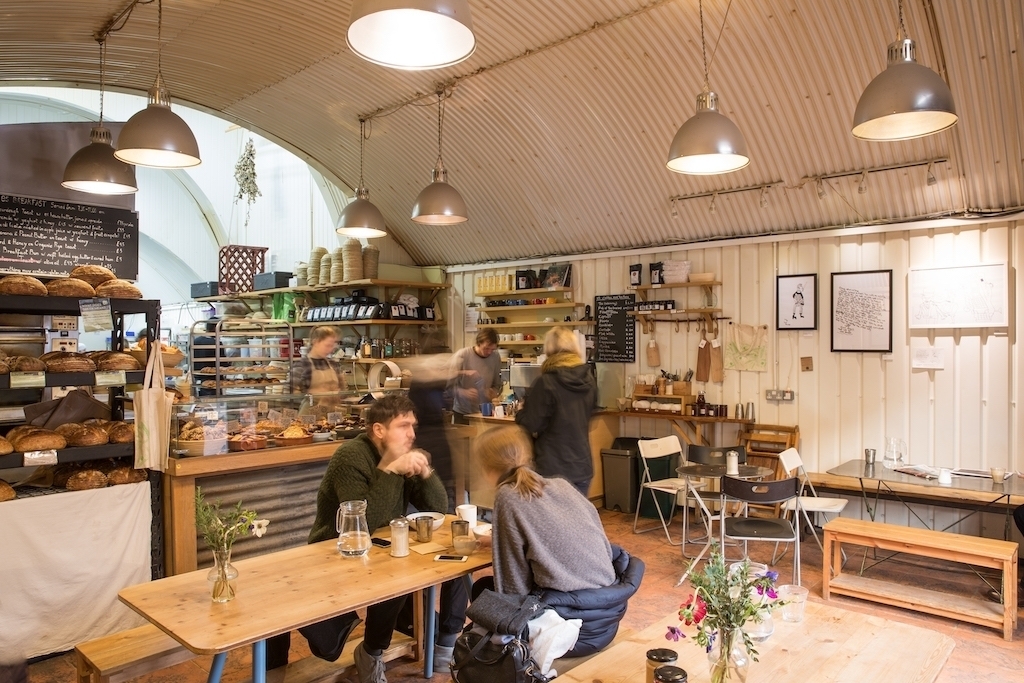Wondering how to cut food waste when cooking at home? Looking for sustainable restaurants and places to eat? Award-winning eco-friendly chef Adam Handling is here to help…

Adam Handling by Tim Green
Adam Handling
Multiple award-wining Scottish chef Adam Handling began his culinary journey as the first ever trainee chef at luxury hotel Gleneagles, going on to become the youngest ever head chef at Fairmont in St Andrews. He is now the chef-owner of four London restaurants, two bars and a deli, and recently became chef patron at new Chelsea hotel Belmond Cadogan – aged just 30.
Sustainable dining is a big part of Adam’s ethos. His deli, Bean & Wheat, focuses on reducing food waste, cleverly using offcuts from his neighbouring restaurant, The Frog Hoxton. Last year he opened a restaurant in Chelsea, Ugly Butterfly, which promises a luxurious take on zero waste dining, and two of his other venues, Eve Bar and Adam Handling Chelsea, are completely zero waste.

Bean & Wheat, Tim Green
‘I opened my sustainable café and beer shop, Bean & Wheat, because sustainability is a key focus for my group. We’re aiming eventually to be 100 per cent zero waste, and Bean & Wheat goes a long way in helping that mission. The café utilises all by-products and offcuts created in my restaurants, ensuring that nothing is thrown away needlessly. For example, I’ll take the livers from the whole ducks I use in my restaurants and turn it into duck liver parfait to be sold in the café in jars. Now that Bean & Wheat is located at the same site as The Frog Hoxton, it has improved this cycle of sustainability as has reduced our carbon footprint to zero. We also have a food lab at the Hoxton site where we preserve fresh produce with brining, curing and fermenting. This is a great way to reduce waste and preserve food for longer.

Adam Handling Chelsea, Tim Green
We’re always looking at new ways to improve on what we’ve already achieved, but my approach to sustainability and zero waste will always be at the heart of my venues. Eve Bar and the recently opened bar at Adam Handling Chelsea are completely zero waste. We use the by-products from the restaurants, peelings and watermelon rinds to produce drinks and garnishes.’
Adam’s Top Tips: How To Cut Food Waste At Home
There are so many ways to reduce food waste. Just taking a second to think “have I absolutely exhausted all possibilities with this ingredient?” before throwing it away is a great start. I think the most important thing that we can do as chefs is to encourage and share our knowledge with as many people as we can. What we do in our kitchens to reduce food waste can also be implemented at home and I hope to encourage as many people as I can to adopt sustainable techniques in their own kitchens – it’s about changing attitudes. As well as having an impact on the environment, you will also find that reducing waste saves you money – what’s not to love?
- There are parts of vegetables that are often thrown away. However, by being creative, you’ll find there are many ways to use scraps to make other dishes. In my restaurants, anything that can be used gets used. When cooking at home, you can add the often-discarded stalks of vegetables to stir fries or blitz them into soups or a pesto. If you’re making a Sunday lunch, don’t throw away the broccoli or cauliflower stalks, instead keep them and roast them in the oven to make a salad for the next day.
- We pickle, ferment and age everything that you can possibly think of – it’s a great way to preserve fresh produce and limit food waste by using scraps. It’s also easy to do at home and you can make your own kimchi by pickling cauliflower leaves. Just cover in salt and water for about 48hrs, then rinse the leaves and make a kimchi paste of garlic, ginger, rice wine vinegar and gochugaru. Cover the leaves with the paste and leave in a sealed jar away from sunlight in a reasonably cool space to ferment. The longer you leave it, the more sour becomes. I love to dice my kimchi and eat it with roast pork.
- Write a food list before you go shopping and stick to it! It’s easy to get drawn in by all the choice at supermarkets. The main thing is to use British wherever possible and be smart with the products you’re using. Buying British fruit and vegetables in season is key for living more sustainably – not only is it better for the environment but the flavour is so much better. Being spring, there is an abundance of fantastic ingredients in season including asparagus, rhubarb and wild garlic. At Frog by Adam Handling in Covent Garden we have a fantastic spring dish of asparagus with garlic emulsion and garlic flowers. It’s great to be able to celebrate and showcase British produce when it’s at its best.
Adam’s Pick: The Best Zero Waste Restaurants

E5 Bakehouse: An independent café/bakery in Hackney which uses locally sourced produce, including London-milled flours to make a wide range of delicious breads.

Daylesford: The cafe and farm shop sell organic meat and dairy along with seasonal fruit and vegetables, which all come from their sustainable farm in the UK.
Silo: I’ve known Dougie McMaster for a while and admire what he’s created with Silo. His zero-waste restaurant has now moved from Brighton to Hackney this summer.
The Zero Waste Food Movement / Sustainable Cafes & Coffee Shops in London
The post A Chef’s Guide To Sustainable Dining appeared first on What's On? By C&TH.
Sofa giá rẻ
https://sofagiarehcm.hatenablog.com
0975488488
981 Huỳnh Tấn Phát, P. Phú Thuận, Quận 7, TP Hồ Chí Minh
Sofa giá rẻ
Không có nhận xét nào:
Đăng nhận xét